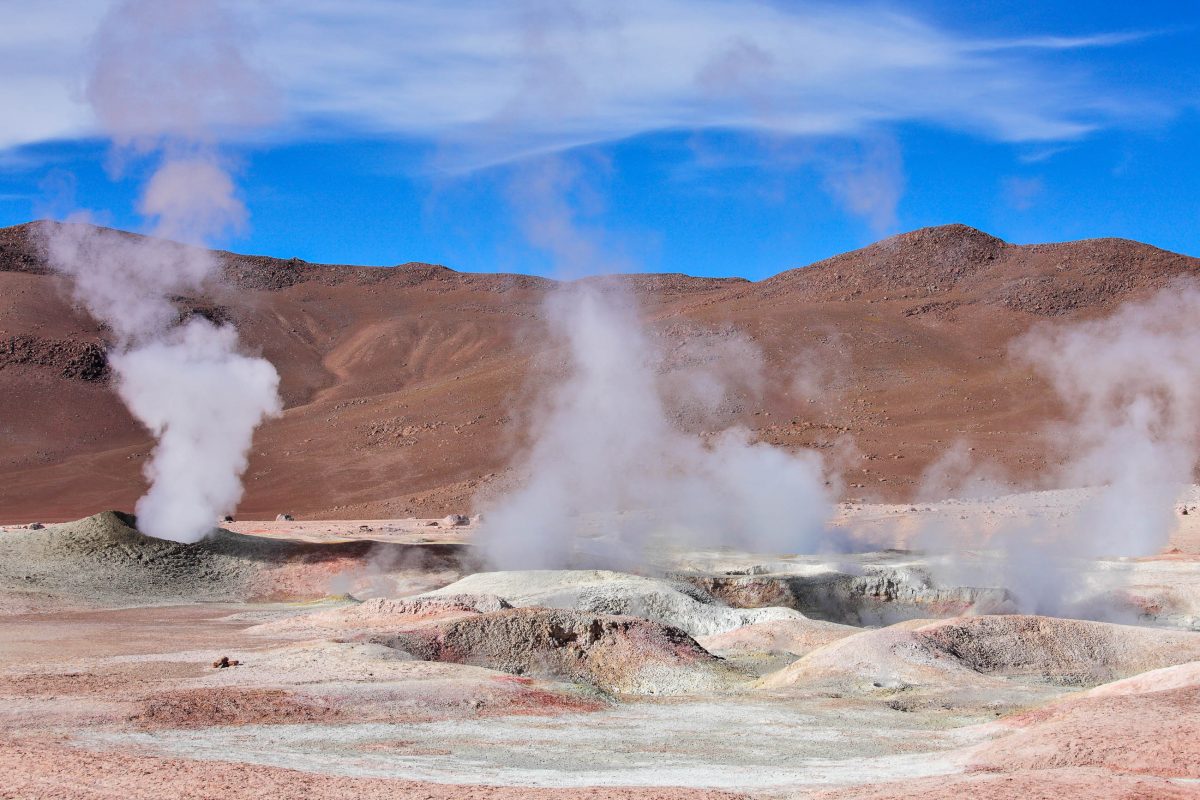Die Geysire von Sol de Mañana liegen in der atemberaubenden Wüstenlandschaft Boliviens im Department Potosí. Mit einer Höhe von 4.850 bis 4.910 Metern ist das Sol de Mañana das höchstgelegene Geysirfeld der Welt.
Das etwa 10 Quadratkilometer große Geysirfeld Sol de Mañana in Bolivien ist berühmt für seine spektakulären vulkanischen Aktivitäten. Es liegt südwestlich der smaragdgrünen Laguna Verde und ganz in der Nähe der von Flamingos bevölkerten Laguna Colorada.
Auf einer Höhe von 4.850 bis 4.910 Metern gelegen ist es das höchstgelegene Geysirfeld der Welt. Auf unserer Liste der Top 10 Sehenswürdigkeiten von Bolivien hat es einen fixen Platz.
Warum heißt das gottverlassene Geysirfeld „Sonne des Morgens“? Weil sein Erscheinungsbild in der aufgehenden Sonne noch einmal um einiges spektakulärer erscheint als tagsüber.
Inhaltsverzeichnis
BILDER: Geysire von Sol de Mañana
Fotogalerie: Geysire von „Sol de Mañana“
Hinter den bunten Bergen…

Schon die Fahrt nach Sol de Mañana ist ein kleines Abenteuer. Die Piste führt durch eine Mondlandschaft aus gelben-orange-rot-braunen Bergen, die vor dem azurblauen Himmel in fast 5.000 Metern Höhe einen unvergesslichen Anblick darstellen.
Diese Hügelkette wird nicht umsonst „coloured mountains„, „bunte Berge“ genannt. Die Farbenpracht entstand durch die vulkanische Aktivität während der Auffaltung der Berge. Ablagerungen von Kupfer, Eisen und anderen Sulfaten verleihen den Bergflanken ihr buntes Erscheinungsbild.
Die karge Wüstenlandschaft wird immer wieder von skurrilen von Wind und Wetter gestalteten Figuren unterbrochen. Auf etwa 4.400 Metern Höhe tauchen dann die ersten heißen Quellen auf, in manchen von ihnen kann man seine Füße wärmen.
…liegen die brodelnden Löcher

Je weiter man in das Gebiet der Sol de Manana hineinfährt, desto wilder wird die Landschaft. Brodelnde Lavaseen, kochende Schlammpfützen und heiße Quellen wechseln sich ab mit rauchenden Flüssen und gischt-sprühenden Erdlöchern. Zeitweise herrscht eine Stimmung wie kurz nach der Entstehung der Erde. Alles ist heiß und dampfig, der Boden raucht und zischt und stößt weiße Fontänen von Dampf und Wasser bis zu 50 Metern in die Höhe.
Die Fumarolen, rauchende Löcher im Boden, und die Geysire, die wasserspeienden Erdlöcher, verströmen einen höllischen Duft nach Schwefel. Die lebensfeindliche Umgebung aus Dampf und Gasen und noch dazu die große Höhe schaffen für Tiere eher schwierige Überlebensbedingungen. Nur ein paar Vikunjas, Lama-ähnliche Geschöpfe des südamerikanischen Hochlandes, treiben sich zwischen den brodelnden Löchern im Boden umher.





